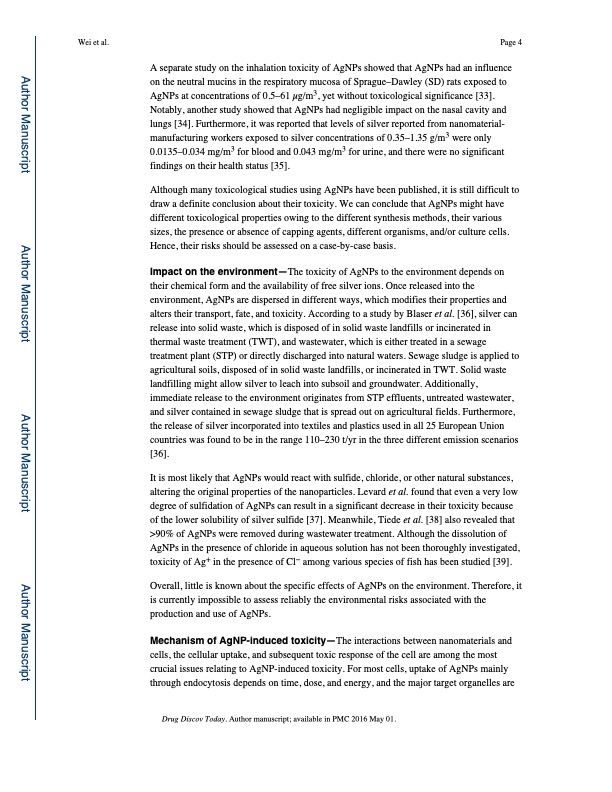
PDF Publication Title:
Text from PDF Page: 004
Wei et al. Page 4 A separate study on the inhalation toxicity of AgNPs showed that AgNPs had an influence on the neutral mucins in the respiratory mucosa of Sprague–Dawley (SD) rats exposed to AgNPs at concentrations of 0.5–61 μg/m3, yet without toxicological significance [33]. Notably, another study showed that AgNPs had negligible impact on the nasal cavity and lungs [34]. Furthermore, it was reported that levels of silver reported from nanomaterial- manufacturing workers exposed to silver concentrations of 0.35–1.35 g/m3 were only 0.0135–0.034 mg/m3 for blood and 0.043 mg/m3 for urine, and there were no significant findings on their health status [35]. Although many toxicological studies using AgNPs have been published, it is still difficult to draw a definite conclusion about their toxicity. We can conclude that AgNPs might have different toxicological properties owing to the different synthesis methods, their various sizes, the presence or absence of capping agents, different organisms, and/or culture cells. Hence, their risks should be assessed on a case-by-case basis. Impact on the environment—The toxicity of AgNPs to the environment depends on their chemical form and the availability of free silver ions. Once released into the environment, AgNPs are dispersed in different ways, which modifies their properties and alters their transport, fate, and toxicity. According to a study by Blaser et al. [36], silver can release into solid waste, which is disposed of in solid waste landfills or incinerated in thermal waste treatment (TWT), and wastewater, which is either treated in a sewage treatment plant (STP) or directly discharged into natural waters. Sewage sludge is applied to agricultural soils, disposed of in solid waste landfills, or incinerated in TWT. Solid waste landfilling might allow silver to leach into subsoil and groundwater. Additionally, immediate release to the environment originates from STP effluents, untreated wastewater, and silver contained in sewage sludge that is spread out on agricultural fields. Furthermore, the release of silver incorporated into textiles and plastics used in all 25 European Union countries was found to be in the range 110–230 t/yr in the three different emission scenarios [36]. It is most likely that AgNPs would react with sulfide, chloride, or other natural substances, altering the original properties of the nanoparticles. Levard et al. found that even a very low degree of sulfidation of AgNPs can result in a significant decrease in their toxicity because of the lower solubility of silver sulfide [37]. Meanwhile, Tiede et al. [38] also revealed that >90% of AgNPs were removed during wastewater treatment. Although the dissolution of AgNPs in the presence of chloride in aqueous solution has not been thoroughly investigated, toxicity of Ag+ in the presence of Cl− among various species of fish has been studied [39]. Overall, little is known about the specific effects of AgNPs on the environment. Therefore, it is currently impossible to assess reliably the environmental risks associated with the production and use of AgNPs. Mechanism of AgNP-induced toxicity—The interactions between nanomaterials and cells, the cellular uptake, and subsequent toxic response of the cell are among the most crucial issues relating to AgNP-induced toxicity. For most cells, uptake of AgNPs mainly through endocytosis depends on time, dose, and energy, and the major target organelles are Drug Discov Today. Author manuscript; available in PMC 2016 May 01. Author Manuscript Author Manuscript Author Manuscript Author ManuscriptPDF Image | Silver nanoparticles: synthesis, properties, therapeutic apps

PDF Search Title:
Silver nanoparticles: synthesis, properties, therapeutic appsOriginal File Name Searched:
nihms651778.pdfDIY PDF Search: Google It | Yahoo | Bing
Turbine and System Plans CAD CAM: Special for this month, any plans are $10,000 for complete Cad/Cam blueprints. License is for one build. Try before you buy a production license. More Info
Waste Heat Power Technology: Organic Rankine Cycle uses waste heat to make electricity, shaft horsepower and cooling. More Info
All Turbine and System Products: Infinity Turbine ORD systems, turbine generator sets, build plans and more to use your waste heat from 30C to 100C. More Info
CO2 Phase Change Demonstrator: CO2 goes supercritical at 30 C. This is a experimental platform which you can use to demonstrate phase change with low heat. Includes integration area for small CO2 turbine, static generator, and more. This can also be used for a GTL Gas to Liquids experimental platform. More Info
Introducing the Infinity Turbine Products Infinity Turbine develops and builds systems for making power from waste heat. It also is working on innovative strategies for storing, making, and deploying energy. More Info
Need Strategy? Use our Consulting and analyst services Infinity Turbine LLC is pleased to announce its consulting and analyst services. We have worked in the renewable energy industry as a researcher, developing sales and markets, along with may inventions and innovations. More Info
Made in USA with Global Energy Millennial Web Engine These pages were made with the Global Energy Web PDF Engine using Filemaker (Claris) software.
Infinity Turbine Developing Spinning Disc Reactor SDR or Spinning Disc Reactors reduce processing time for liquid production of Silver Nanoparticles.
| CONTACT TEL: 608-238-6001 Email: greg@infinityturbine.com | RSS | AMP |